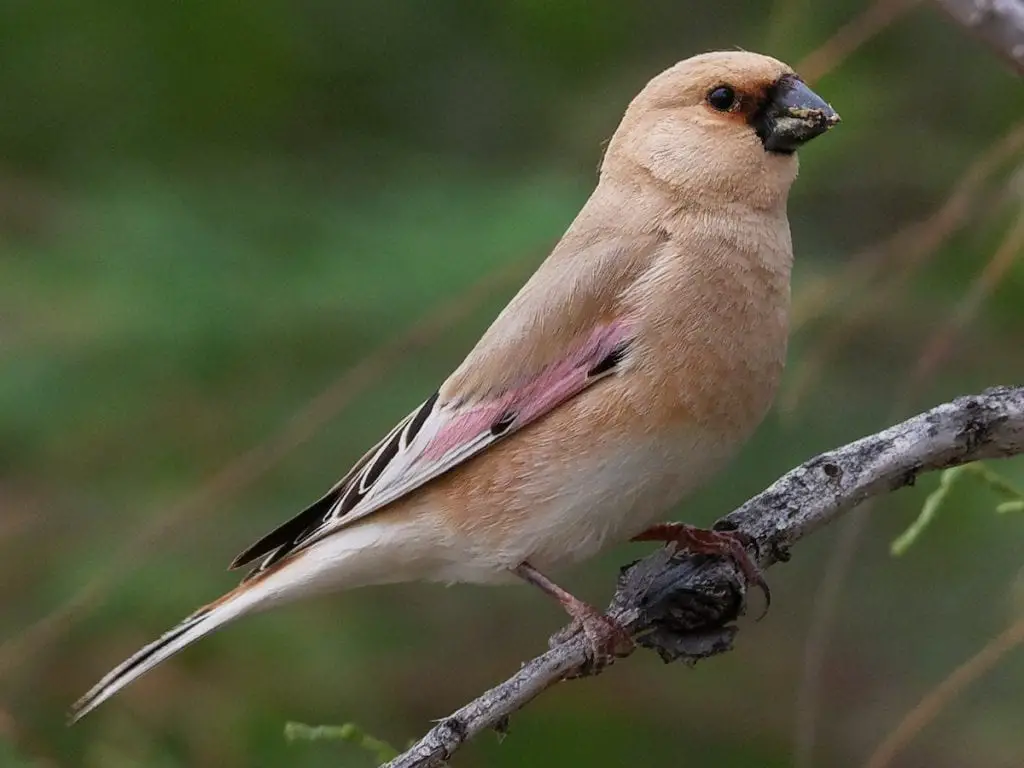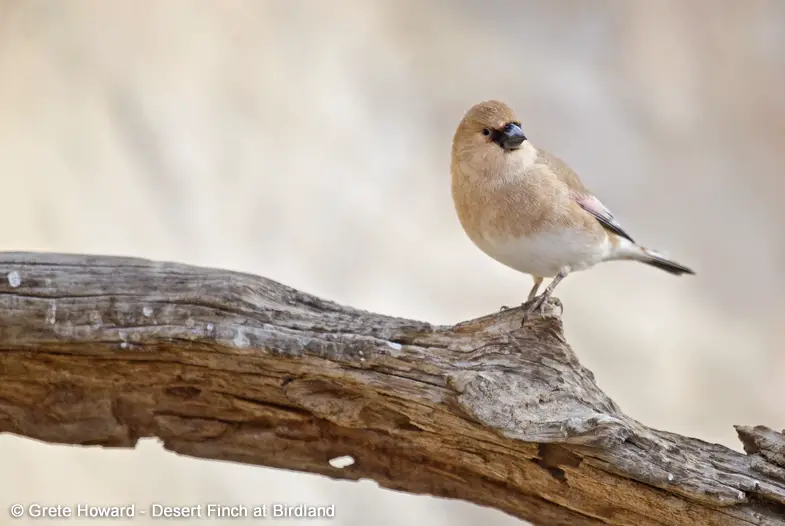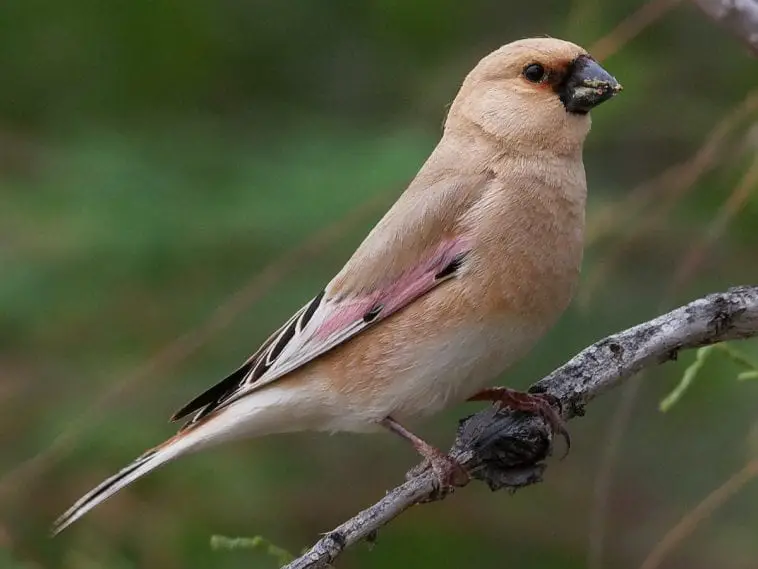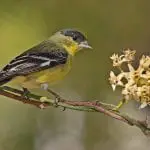Scientific Facts
| Scientific name: | Rhodospiza obsoleta |
| Mass: | 26 g |
| Phylum: | Chordata |
| Order: | Passerine |

Description
Male Desert Finch has a light brownish-sandy layer, cranium, throat, and craw; the layer is somewhat dimmer than the breast. Lores then base-bill feathers are dark. The stomach besides undertail is white. Uppertail besides flanks are clayey-chocolate. Smaller and median wing coverts are rusty-sandy, larger coverts are dark-chocolate with comprehensive pink edges. Flight feathers are dark with white and pink ends on exterior webs. On the curled wing, these edges shaped big pink cover in the central, and white patch nearer to tip. Tail feathers are dark with broad white ends.
Claws are horn-hue; the bill is dark grey-tinged. Female is lighter than male. Flight besides tail feathers are dark-brownish with snowy advantages. Pink cover on the wing is lighter than in the male. Lores besides base-bill feathers are healthy-sandy. Youngsters are alike on females; larger wing coverts are brownish with flushed-yellow tips. Bill is light, off-yellow darkened in wintertime. Dimensions. males: wing 83-90, tail 55-64, tarsus 15,6-17, in addition to bill 8.1-9.8 mm. Female: wing 81-85, in addition to tail 54-60, tarsus 15.5 – 17, bill 8.0 -9.4 mm. Heaviness: 17.5 – 28.0 gr.
Distribution
Desert Finch breeds then happen on relocation in the southern half of Kazakhstan, in north perhaps to Beyneu, Kazalinsk, Dzhezkazgan; definitely up to Dzambul-Gora and northern Betpak-Dala (Zhideli natural border), Ile delta also Zharkent. In 1968 it occurred in Ucharal; in 1978 at Makanchi village; in seasonal 1962 experiential on Mangyshlak at spring Karabota (where today it is shared in places) and in 1965 on western chink of Ustyurt in Manata natural border. Drifters logged on Tengiz lake (2 males and 1 female experiential 1 – 15 April 1983). In wintertime, Desert Finch happens in Syrdarya valley lone.
Biology
Desert Finch is shared breeding traveling. It lives saxaul woods with some exposed areas (salines, clearings), oasis estates, man-made woodland, parks, groves, townships, and cities, favors places near the water, together on plains and in crag up to 800-1200 m. In spring Desert Finch reaches in early-mid March in minor herds of up to 40 birds; spring relocation surfaces in mid-April – early May. Desert Finch breeds in distinct couples at 0.2-1.5 km from each other. Nest is constructed by female, occasionally with some assistance of male; nest is constructed in vegetations or scrubs (saxaul, elm, poplar, mulberry, maple, bastard acacia, as well as apricot) at 1-4 m overhead ground; nest is from thin branches and grass stalks and is furrowed with hair and flora down (in settlements the cotton wool is used very joyfully). Clutches of 3-7, typically 5-6 eggs, originated from mid-April till mid-July.
The only female gestates for around two weeks; this period male fodders her. Equally, parents fodder youths, which fledged at stage 12-13 days old. Two young raised per year. After youths start self-governing life, bird’s intersection in flocks. Autumn relocation at Chokpak Pass starts at the end of August-early September, the mainstream of birds travels in mid-October.
Diet of the Finch
Each class varies in its food. Many feed chiefly on seeds and ounces; nonetheless, other classes are omnivores and fodder on insects and invertebrates in addition to plants.
Insects also invertebrates are a larger percentage of the diet throughout the breeding period. They eat an extensive diversity of foods counting seeds, berries, pods, grains, flies, mosquitoes, in addition to spiders, caterpillars, grasshoppers, and more.
Finch and Human Interaction
Human action impacts dissimilar classes in different habits. Some birds have high inhabitants and wide varieties, and humans do not influence them as deeply. Though, others with smaller inhabitants or limited circulations suffer more profoundly from human action. Things like home destruction, contamination, climate alteration, pesticides, and more all reason populace decline.
Domestication
Humans have tamed a few diverse types of Finches. The most usually tame type is the canary. Humans started breeding canaries in the 17th period. From that period, we have industrialized a wide diversity of colors and designs.
Does the Finch Make a Good Pet
Though wild type does not make decent pets, we have tamed several diverse Finch species. These birds do brand decent pets; nonetheless, they are not chiefly cuddly pets. Individuals typically keep and breed them as birdcage birds and in dovecotes for their pretty insignia and attractive voices.
Conduct of the Finch
As you might have predicted, based on the massive number of diverse species, conduct varies from one type to another. Most types are diurnal and vigorous throughout the day; nonetheless, their separate behavior varies. Some types fodder chiefly on the ground, others in low undergrowth, and others in the crowns.
Informally, many types of Finches are outgoing, or animate in flocks. Flock size differs from type to class; some live in extremely great flocks, whereas others live in minor family groups. Some types are unsociable or live alone.
Reproduction of the Finch
These birds vary radically in their breeding conducts, as well. Some types breed with a similar companion year after year though others have new cohorts every period. Most types shape their nests in foliage or other out of reach zones.
The quantity of eggs per clutch differs from species to types, as does the gestation period and growth of the chicks. Some types fledge and turn out to be independent quite rapidly, though others take extended ages to leave their parents.
Availability and where to get
You can obtain such kind of bird from specialized pet shops in certain areas. You must get referrals and even recommendations from your professional bird owners and breeders.
Fun Facts
1. Finches chiefly live deciduous and perennial forests, hot and subarctic zones, crags, and desert.
2. They make very prevalent pets since of their small scope and the aptitude to produce lovely songs.
3. On regular, finches reach measurement amid 3 and 6 inches. They incline to weigh amid 0.35 and 1.2 ounces.
4. They have brownish or greenish forms that are enclosed with dark, yellow, and pink feathers. Male finches are more brightly tinted than females.
5. The male house finch has a pink colored cranium and breasts. Their red hue comes from the colors in the nourishment that they eat.
6. Female finches incline to favor to mate with pink males since their red-tinted cranium means that the male can deliver the kind of nourishment that the female is viewing for.
7. The yellow-colored cranium on a house finch is a mark of pressure or an insufficient diet.
8. Finches can have minor triangular beaks, dense round beaks, or beaks with crisscrossed tips. Their beak differs on the type and the kind of food they eat.
9. They’re herbivores, meaning that they’re vegetable eaters. Their diet contains diverse kinds of seeds, buds, and berry.
10. Darwin planned his concept of development by watching and probing finches on the Galapagos Islands. Darwin saw that 14 types of Galapagos finches have joint descendants that arrived on the Galapagos Islands millions of ages ago. One specific kind of finch changed into 14 diverse types of birds as a consequence of the version to diverse kinds of food and habitats.
11. They’re outgoing birds that animate in great flocks, which are identified as “charms.” They connect through numerous songs.
12. They’re recognized to be inactive birds, with some type being partly migratory.
13. Finches shape basket formed nests in foliage, scrubs, or gaps of rocks.
14. They lay amid 2 and 6 light blue eggs that hatch after being gestated for 13 to 14 days.
15. They spread sexual adulthood amid the ages of 9 also 12 months.
16. Finch chicks are born naked, blind and helpless at birth. They usually stay in their nest during the first 2 to 3 weeks of their life.
17. House finches are frequently reserved as pets. They have a hard period familiarizing themselves to live close humans; that’s why most owners will evade physical interaction.
18. House finches obligatory the company of other finches to stay fit both bodily and emotionally.
19. Wild finches can animate amid 4 and 7 years, whereas captive finches typically animate for 20 years because of their better living situations.
20. Whereas finches incline to express as much as any other kind of caged domesticated birds, they have tiny singings that don’t transmit as far as greater birds, such as parrots.
21. Before the mating period starts, the male finch will ball on twigs of trees to excite the female finch. They push up their fluff to brand their dance more beautiful.
22. Finch offspring will take black beaks when they’re very new; nonetheless, it will alter to a bright red or carroty color afterward 1 month.
23. When they breed and have offspring in the layer, male finches will turn out to be very defensive over the nest.
24. Finches are rapid to familiarize themselves with new environs; nonetheless, they’re very fond of being in open parts with lawns and scrubs.
Common Diseases
Sources of Diseases
Avian illnesses and infections are continuously present and occasionally extensive in birds and other animals throughout the world. Some illnesses and parasites are held inside or on birds enduringly or for shorter amounts of period. Some are deadly to the multitude. Occasionally birds just become diseased without becoming extinct nevertheless act as transporters of the illness, dispersal it to other others inside their populace. Most illnesses can be drawn to several roots: viruses, fungiform sources, microbial, or parasites, either outside or internal. Most vermin are blood-suckers or have bad effects on moreover/or red besides white blood cells.
Parasites and Pathogens
Many organisms’ advance nutrients and get vigor by nourishing on birds. The main of these organisms are large enough to slay and consume a bird – we mention to them as marauders. Most readers are acquainted with characteristic bird marauders such as local and feral cats, additional birds (hawks, roadrunners, etc.), snakes, coyotes, etc. Minor animals big enough to perceive with the naked eye are typically mentioned as parasites. They might be related to a bird for a generation or a comparatively short period.
They can animate on or in the bird. Parasites might or may not be a grave threat to the bird. Many lack the aptitude to make the bird sick or reason a deadly illness. Instances of external vermin that eat on birds contain, nonetheless, are not incomplete to bird lice, fleas, black besides louse flies, Hemiptera (minor bugs connected to bed bugs), ticks, also, mites.
They are completely bloodsuckers. Internal parasites comprise roundworms, tapeworms, flukes besides others that animate in the gastric tract or the blood vessels of birds. More learning is essential to fully comprehend the influences that parasites have on birds nonetheless ornithologists usually decide that in the general arrangement of things, parasites are further of a problem to regally nesting types (because of the birds’ close nearness to each other) than to individuals of any assumed type. Micro-organisms, which comprise protozoans, microorganisms, fungi, viruses, then rickettsiae (tiny microorganisms like organisms), can be deadly to diseased birds and are usually mentioned as pathogens.
Botulism
Botulism in nature is a microbial sickness born from earth and hatched by warm liquid and sunlight. Before recognized as “western duck illness,” epidemics can disturb big numbers of birds, chiefly ducks, and other traveling waterfowl types found in connotation with bigger bodies of low water. Two well recognized cases complicated big numbers of aquatic and shore natures at the Great Salt Lake in northern Utah in 1929, where up to 3 million ducks and other waterfowl expired and the Salton Sea in southern California, where decease-offs from botulism complicated hundreds of thousands of birds with epidemics happening more than a few times over a period of ages.
Some of the initial information on this illness in the United States age back to 1876. Botulism is likewise one of the most lethal illnesses for humans to encounter. Though, humans don’t get botulism from the setting nonetheless, somewhat, from defective canned and treated foods.

Relationships to Humans
There is a great diversity of bird illnesses and diseases, hundreds universal. Avian Malaria (dissimilar than human malaria) besides West Nile is produced by protozoans carried by mosquitos, as is Aspergillosis (a fungiform contagion) and Tuberculosis (not the similar pathogen that reasons human tuberculosis). Numerous other viral illnesses, for example, Newcastle disease, fowl wave, avian pox, avian influenza (flu), and others are related to birds. Most avian illnesses are not movable to humans; nevertheless, birds can aid as hosts to pathogens that can reason grave human diseases.
For instance, the rickettsia that details psittacosis is occasionally contracted by humans who retain parrots as animals. Psittacosis may be deadly to humans that don’t get handling. The identical is true of equine encephalitis disease. The virus is typically passed to birds and horses from mosquitoes. Further blood-sucking mosquitoes might prey upon an ill bird before preying on an unwary human. Traveling birds have been concerned in the transport of infectious encephalitis strains amid continents.
Coccidiosis
Coccidiosis is an additional illness that is carefully related to certain wild birds, chiefly quail. Coccidia is parasitic protozoans that live the gastric tracts of birds and is carefully associated with the nourishment’s birds swallow. It is also a periodic wonder, contingent on which foods are in period at a given the time of day. Beginning in the 1940s, much study was proficient regarding this illness, chiefly with California Quail. The investigation resolute that there was a direct association between the period of a year and the foods spent seasonally – a lower strength of contagion in summer when quail were ingestion more seeds than the respite of the year when they were consumption more green vegetable foods.
This illness is also recognized to affect certain types of ducks, chiefly goldeneyes, and canvasbacks. It has been originated in pelicans, cormorants, shorebirds, besides some other types. It makes intelligence that hawks that quarry upon unhealthy birds can also turn out to be victims of the illness themselves.
Habitat Maintenance
Clean and sterilize the home and roosts frequently with a 3% bleach solution; change substrate or home liner weekly or more frequently as required.
Replace roosts, saucers, and toys when damaged or dented; alternate new toys into the home frequently.
Guarantee that there are no home portions or toys with lead, zinc, or lead-based dyes or stimulated parts as these can reason serious medicinal matters if swallowed by your bird.
Do not usage a great deal of cleaning agents about your bird as the vapors can be damaging. It is suggested to use natural cleaning merchandise.
Grooming & Hygiene
Deliver drinkable, chlorine-free, lukewarm water frequently for bathing; eliminate the water when completed. As a substitute, vapor the bird with water.
Nails must be clipped by a competent person to stop wound to the bird.
Health
Signs of a Fit Animal
- Active, attentive, and friendly
- Eats and drinks through the day
- Dry nares besides cheerful, dry eyes
- Beak, legs besides feet standard in appearance
- Unsoiled, dry vent
- Even, well-groomed feathers
Red Flags
- beak bulge or buildups
- bungled, plucked, or grubby feathers
- sitting on the floor of the home
- puffed or coughing
- runny or stained stools
- favoring one foot when not asleep
- eye or nasal emancipation
- red or distended eyes
- loss of hunger
Care Sheet
Diet
A well-balanced finch régime contains:
Particular pellets must make up 60 to 70% of food, plus new vegetables, fruits besides small quantities of fortified seeds.
Clean, new, drinkable, chlorine-free water, altered day-to-day.
Do not fodder bird avocado, fruit seeds, chocolate, caffeine, or liquor as these can reason serious medicinal conditions. Evade sugar and high-fat delicacies.
Feeding
Things to think of when nourishing your finch:
- Fresh nourishment and water must always be obtainable.
- Vegetables besides fruits not eaten within a small number of hours must be castoff.
- Think of; treats must not surpass 10% of total nourishment.
Housing
Finches adapt well to regular domestic temperatures, not to drop under 65°F or to surpass 80°F; be careful of thrilling temperature variations. The home must be located off the floor in a part that is well-lit and away from breezes.
A rectangular flight home, about 24″W x 14″ D x 18″H, with metal bars spread out no greater than 3/8″ separately, makes a good home-based for up to 3 inches. Flight home is powerfully suggested. It is best to deliver the main habitat likely.
Perches must be as a minimum 3″ extended and 1/4″- 1/2″ in diameter; a diversity of roost dimensions to work out feet and help avert arthritis is suggested.
A metal grate ended the droppings tray will retain the bird away from mucks; line the stools tray with environment paper or suitable substrate for easier scrubbing. To avoid pollution, do not place nourishment or water ampules under roosts.
Finches can be reserved with no less than one other Finch, rather more. Finches can be contained with numerous other flocks, non-violent species in an aviary. Contingent on the type, some finches can be contained with other kinds of finches. Diverse forms of birds must not be contained together.
Birds should be mixed every day by the pet parent tenderly speaking to the bird.
Habitat Maintenance
- Clean and sterilize the environment and roosts frequently with a 3% bleach solution; substitute substrate or home liner weekly or more frequently as needed.
- Replace roosts, dishes, and figurines when shabby or dented; interchange new toys into the habitat habitually.
- Guarantee that there are no home parts or figurines with lead, zinc, or lead-founded dyes or stimulated parts as these can source serious medical problems if swallowed by your bird.
FAQ Section
Do finches need to be enclosed in the evening?
Finches are eventful little birds and seem to relish flying from one layer to another. If a bird is reserved in a full part of the home, even if the birdcage is enclosed in the evening, if the TV or processer is still on the bird will not obtain the proper break that it needs to uphold good fitness.
Do finches favor to be held?
Though finches cannot be controlled quite such parrots, finches are sufficient fun to attend to and watch. They come in a diversity of spectacular insignia and make silent noises that numerous find enjoyable.



